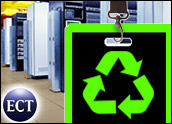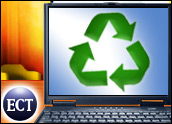
Green’s got the blues.
“Dark Days for Green Energy,” declared a headline in the Feb. 4 issue of The New York Times. “(B)ecause of the credit crisis and the broader economic downturn … installation of wind and solar power is plummeting,” reported the Times.
Green energy’s melancholia extends to cousin “green IT” (aka “green computing”) — the movement toward a more environmentally friendly and cost-effective use of power, production and waste reduction methods in technology. Green IT measures go from the general (adopting a green management philosophy across an entire company or industry, from process to product design and life cycle to workplace) to the specific (improving energy efficiency for data centers by reducing power and cooling consumption, saving paper through the reduced use of printing and document handling, recycling old computers and properly disposing of hazardous “e-waste” from electronic products containing substances like lead and mercury).
The sorry results of recent tech industry efforts at going green were highlighted in GreenerComputing.com’s report on “The State of Green IT in 2009,” issued on Feb. 3, which detailed the “hefty costs” from our ever-growing reliance on computers.
“For the second year in a row … our growing mountains of e-waste are vastly outpacing the amount of electronics that we’re taking in for processing,” wrote Matthew Wheeland, managing editor of Greener World Media. “Although the EPA estimates that there are roughly 1.3 million tons of electronics at the end of their lives, in 2007 we only collected 244,000 tons of electronics — barely one-sixth of the total waste stream.”
It’s In the Way That You Count It
The problem is in the counting, according to Wheeland.
“The issue here in the U.S. is that there really is no way to currently gauge amounts of waste sent in aggregate by the IT industry to landfills or to be recycled, and I think that needs to change,” Wheeland told the E-Commerce Times.
Part of what is required is stronger federal-level controls over what can be exported from the U.S. for processing (the ideal goal being zero exports of waste), but also stronger requirements for manufacturers to take back electronics at the end of their functional lives, he said.
“There are moves underway to require manufacturers to pay to take back all their electronics, and that is a solid idea, although it’s obviously under fire from the industry itself,” Wheeland noted. “Regardless of how it’s accomplished, I would say good measures of success on the e-waste front would involve goals for computers to be made of entirely recyclable and reusable materials, as well as a system to ensure that any kind of electronic device can be easily returned to a manufacturer or recycler for proper and safe disposal.”
Meanwhile, the gloom on computing’s green front has gone global because many American businesses have been looking to outsource their green IT responsibilities. Unfortunately, the outsourcing service providers are often located in India (whose tech industry is the world’s fastest-growing emitter of CO2) and China (the world’s largest air polluter).
The Great Greenwash
Greenwashing is the practice of boasting a pro-environmental stance that’s purely superficial. It’s all too common in the outsourcing business, according to “The Black Book of Outsourcing” and Boston-based Brown-Wilson Group, which asserted in a recent report that offshore outsourcing vendors often “radically disregard” the environmental impact of their work.
“U.S. and UK businesses have risked their corporate accountability for the environment on offshore outsourcers without seeing any substantive efforts,” said Doug Brown, managing partner in Brown-Wilson Group, sponsor of the survey in which 4,200 North American, European and Japanese IT executives were interviewed.
The problem, according to Brown, starts when the sales teams from outsourcing companies drive the differentiator that it is “greener” for their client companies to hand over IT to the outsourcing vendor, thus pushing total responsibility for saving energy and lowering emission of toxic waste onto the vendor, which then fails to perform.
“CIOs have lost patience with vendors loitering on the issues of sustainability,” Brown told the E-Commerce Times. “Many depended on the vendor’s word to produce innovative green strategies, which have not materialized.”
The most gripping wake-up call is for the Indian and Chinese IT suppliers, since a total of 88 percent of tech executives who manage contracts with these sourcing providers report getting predominantly green-washed initiatives thus far, according to the survey.
“India’s focus as the world’s best trained, low-cost service destination of choice has not found effective ways to deliver on grander sustainability guarantees,” concluded Brown.
Lenovo Nearly Verdant
One global player taking green IT seriously is Lenovo, China’s largest and the world’s fourth largest (since its 2005 purchase of IBM’s PC division) PC manufacturer, after HP and Dell of the U.S. and Acer of Taiwan. Lenovo produces desktops, laptops, servers, handheld computers, imaging equipment and mobile phone handsets.
Since July 2007, Lenovo notebooks, desktops, and TFT monitors can be configured as Energy Star 4.0 compliant (Energy Star is an international standard for energy efficient consumer products). Lenovo has also developed Asset Recovery Services (ARS) to help business customers in the U.S. and Canada manage their end-of-life technology equipment by providing computer take-back, data destruction, refurbishment and recycling. Lenovo also offers additional services including inventory, value assessment, on-site deinstallation and data encryption. Lenovo can even facilitate the donation of old computers or help customers receive cash back for them. In October 2008, Lenovo announced the M58/M58p, its “greenest” desktop PC to date, with technology that allows PC users to control their electricity consumption remotely.
“Building more green attributes into consumer electronics products typically requires increased costs in producing the product, so consumers will determine how much they are willing to pay up front for greener products,” said Mike Pierce, Lenovo’s director of environmental affairs. “Some green attributes, like energy efficiency, can have direct payback to the consumer over time, such as in avoided energy usage.”
However, Pierce sees a problem with prominent “eco” labels — such as Energy Star, the Green Electronics Council’s Electronic Products Environmental Assessment Tool (EPEAT) for assisting in the purchase of “green” computing systems, the Climate Savers Computing Initiative (CSCI) to reduce the electric power consumption of PCs, the Greenguard Environmental Institute (GEI) industry-independent, third-party certification program for testing low-emitting products and materials, and numerous others.
“These programs exist to help consumers purchase greener electronics,” he noted. “However, since they measure different attributes, there is no clear industry definition of green electronics.”
Oops.
His solution? “By purchasing greener products, consumers can help increase the selection of greener products,” Pierce told the E-Commerce Times.
‘Green’-vernment
The U.S. government isn’t leaving industry out on the green limb all by itself. In addition to Energy Star (created in 1992 by the U.S. Environmental Protection Agency), numerous governmental agencies have continued to implement standards and regulations that encourage green computing. But the EPA continues to shine as the Fed’s go-to green booster.
The EPA’s Green Power Partnership is a voluntary program that supports the organizational procurement of green power by offering expert advice, technical support, tools and resources. Partnering with EPA in this way is supposed to help companies lower the transaction costs of buying green power and reduce an organization’s carbon footprint.
“Green power is electricity produced from a subset of renewable resources, such as solar, wind, geothermal, biomass, and low-impact hydro,” states the EPA Web site. “Buying green power is one of the easiest and most effective ways to improve your organization’s environmental performance.”
Then there are “Renewable Energy Certificates” (RECs), also known as “green tags;” “Renewable Energy Credits,” or “Tradable Renewable Certificates (TRCs)” — tradable environmental commodities in the U.S. which represent proof that one megawatt-hour (MWh) of electricity was renewable (generated from an eligible renewable energy resource). These certificates can be sold and traded and the owner of the REC can claim to have purchased renewable energy. (Can anyone say “green blackmarket?”)
Where Goest Green?
Green computing doesn’t lack for big-name tech biz boosters. The Green Grid is a global consortium dedicated to advancing energy efficiency in data centers and business computing ecosystems. It was founded in February 2007 by AMD, APC, Dell, HP, IBM, Intel, Microsoft, Rackable Systems, SprayCool, Sun Microsystems and VMware. The Green Grid has since grown to hundreds of members, including end-users and government organizations, all focused on improving data center efficiency.
But are high-profile names enough?
“The biggest challenges facing green IT right now are twofold: raising awareness outside of the industry and raising performance within,” said Greener World Media’s Wheeland. “For the former: The tendency in tough economic times is to hunker down, to cut back all but the most necessary spending in order to weather the storm. However, in the case of IT, companies sitting on outdated, highly inefficient machines — whether they’re old PCs or old servers — are potentially losing more money than if they were to upgrade to newer, more efficient hardware or implement relatively inexpensive but often highly impactful PC power management projects.”
“Green, social and economic sustainability are now being driven as much by business strategy and the demands of clients as by a sense of corporate responsibility,” according to Scott Wilson, a partner at Brown-Wilson Group and co-author of “The Black Book of Outsourcing.” “We’re way past the need for global standards beyond energy-efficient hardware, hosted infrastructure and data center virtualization, but it’s a start.
“Although the focus on green has increased, we will only see an industry-wide change once governments implement legislation to make going green an obligation, with a green schedule in contracts and a green benchmark clause in every outsourcing agreement,” he concluded.













































Social Media
See all Social Media